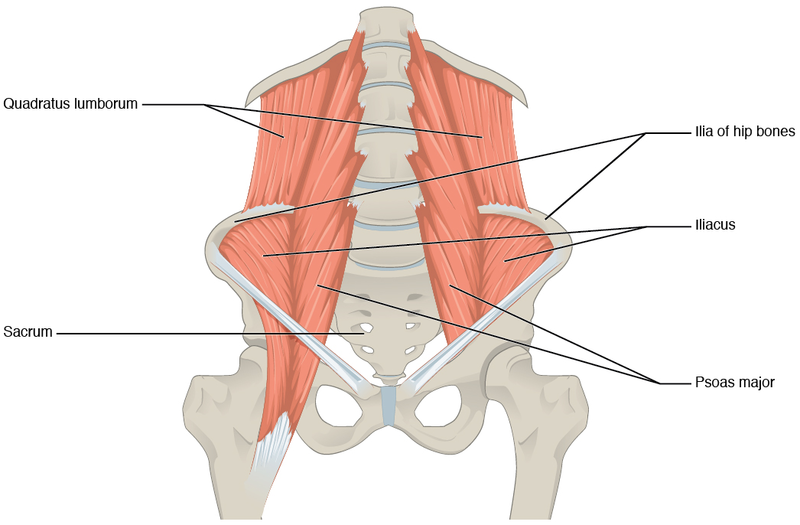
Anatomy
Abdomen
The psoas major muscles acts to produce which of the following movements:
Answer:
The psoas major muscle flexes the thigh at the hip joint when the trunk is stabilised and flexes the trunk against gravity when the body is supine.Posterior Abdominal Wall Muscles
Anatomy / Abdomen / Posterior Abdominal Wall
Last Updated: 11th April 2019
The most important muscles of the posterior abdominal wall are the psoas major, the iliacus and the quadratus lumborum which each possess a strong fascial covering. Associated with the psoas major muscle is the psoas minor muscle, which is sometimes absent.
Table: Function and Innervation of the Posterior Abdominal Wall Muscles
| Muscle | Extent | Function | Innervation |
|---|---|---|---|
| Psoas major | Originates from vertebrae T12 – L5, covers anterolateral bodies of lumbar vertebrae and fills in spaces between vertebral bodies and transverse processes, passes inferiorly along pelvic brim and attaches distally to lesser trochanter of femur | Flexes thigh at hip joint when trunk is stabilised, flexes trunk against gravity when body is supine | Anterior rami L1 – L3 |
| Quadratus lumborum | Fills space between rib 12 and iliac crest on both sides of vertebral column, overlapped medially by psoas major muscle, lies medial to transversus abdominis muscle | Depresses and stabilises twelfth rib, contributes to lateral bending of trunk | Anterior rami of T12 and L1 – L4 |
| Iliacus | Fills iliac fossa on each side before passing inferiorly to join with psoas major muscle and attach distally to lesser trochanter of femur | Flexes thigh at hip joint when trunk is stabilised, flexes trunk against gravity when body is supine | Femoral nerve (L2 – L4) |
Psoas Major
The psoas major originates from the lateral bodies of, the transverse processes of and the intervertebral discs between the T12 and L1 - L5 vertebrae, essentially covering the anterolateral surface of the bodies of the lumbar vertebrae and filling in the spaces between the vertebral bodies and the transverse processes. It passes inferiorly along the pelvic brim and continues into the anterior thigh to attach to the lesser trochanter of the femur.
The psoas major flexes the thigh at the hip joint when the trunk is stabilised and flexes the trunk against gravity when the body is supine.
It is innervated by the anterior rami of nerves L1 - L3.
The lumbar plexus forms within the psoas major muscle, anterior to its attachment to the transverse process of the lumbar vertebrae.
Quadratus Lumborum
The quadratus lumborum muscles essentially fill the space between rib 12 and the iliac crest on both sides of the vertebral column. They are overlapped medially by the psoas major muscles and along their lateral borders are the transversus abdominis muscles.
The quadratus lumborum muscles depress and stabilise the twelfth ribs and contribute to lateral bending of the trunk. Acting together, the muscles may extend the lumbar part of the vertebral column.
They are innervated by the anterior rami of T12 and L1 - L4.
Iliacus
The iliacus muscle fills the iliac fossa on each side, before passing inferiorly to join with the psoas major muscle (forming the iliopsoas muscle) and attach to the lesser trochanter of the femur.
Like the psoas major, the iliacus flexes the thigh at the hip joint when the trunk is stabilised and flexes the trunk against gravity when the body is supine.
It is innervated by branches of the femoral nerve.

Muscles of the Posterior Abdominal Wall. (Image by OpenStax College [CC BY 3.0 (https://creativecommons.org/licenses/by/3.0)], via Wikimedia Commons)
Report A Problem
Is there something wrong with this question? Let us know and we’ll fix it as soon as possible.
Loading Form...
- Biochemistry
- Blood Gases
- Haematology
| Biochemistry | Normal Value |
|---|---|
| Sodium | 135 – 145 mmol/l |
| Potassium | 3.0 – 4.5 mmol/l |
| Urea | 2.5 – 7.5 mmol/l |
| Glucose | 3.5 – 5.0 mmol/l |
| Creatinine | 35 – 135 μmol/l |
| Alanine Aminotransferase (ALT) | 5 – 35 U/l |
| Gamma-glutamyl Transferase (GGT) | < 65 U/l |
| Alkaline Phosphatase (ALP) | 30 – 135 U/l |
| Aspartate Aminotransferase (AST) | < 40 U/l |
| Total Protein | 60 – 80 g/l |
| Albumin | 35 – 50 g/l |
| Globulin | 2.4 – 3.5 g/dl |
| Amylase | < 70 U/l |
| Total Bilirubin | 3 – 17 μmol/l |
| Calcium | 2.1 – 2.5 mmol/l |
| Chloride | 95 – 105 mmol/l |
| Phosphate | 0.8 – 1.4 mmol/l |
| Haematology | Normal Value |
|---|---|
| Haemoglobin | 11.5 – 16.6 g/dl |
| White Blood Cells | 4.0 – 11.0 x 109/l |
| Platelets | 150 – 450 x 109/l |
| MCV | 80 – 96 fl |
| MCHC | 32 – 36 g/dl |
| Neutrophils | 2.0 – 7.5 x 109/l |
| Lymphocytes | 1.5 – 4.0 x 109/l |
| Monocytes | 0.3 – 1.0 x 109/l |
| Eosinophils | 0.1 – 0.5 x 109/l |
| Basophils | < 0.2 x 109/l |
| Reticulocytes | < 2% |
| Haematocrit | 0.35 – 0.49 |
| Red Cell Distribution Width | 11 – 15% |
| Blood Gases | Normal Value |
|---|---|
| pH | 7.35 – 7.45 |
| pO2 | 11 – 14 kPa |
| pCO2 | 4.5 – 6.0 kPa |
| Base Excess | -2 – +2 mmol/l |
| Bicarbonate | 24 – 30 mmol/l |
| Lactate | < 2 mmol/l |

